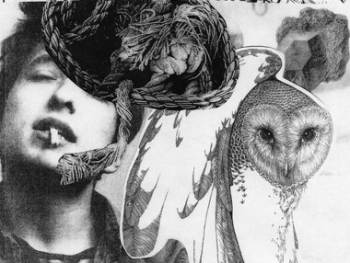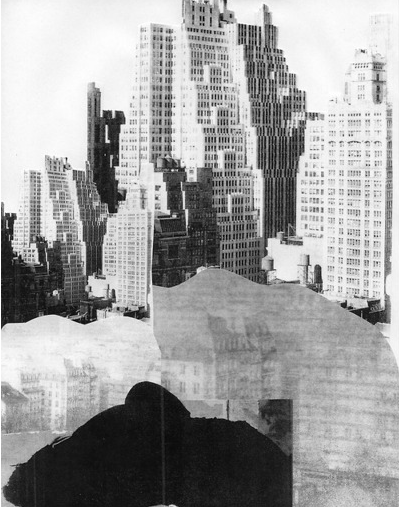The Assembled Picture Library of New York City
The Assembled Picture Library of New York City
by Eric J. Herboth

Esopus Space, the New York exhibition and performance venue operated by the same nonprofit foundation that publishes Esopus magazine, is currently playing host to The Assembled Picture Library of New York City, a new art show-cum-workshop brainstormed by artists Robin Cameron and Jason Polan. It’s a collaborative exhibition; it’s a workshop: it merges the notions of gallery exhibit, art studio and potluck dinner into an interactive exercise that the two New York-based artists hope will “create a collaborative and creative relationship with the general public, and also to enable a sense of community around artists’ processes.”
The gist of the project is an attempt to burrow into that narrow, often disorienting slice of artistic work that truly relies on the execution of a concept to achieve its footing. The outcome of experiments in conceptual art can be anyone’s guess going in — the very point of such an exercise is for the idea itself to wrestle the proverbial brush from the artist’s hand and manifest itself like magic. More often than not, the execution of such exercise is rendered as an inconsequential logistic on the checklist navigating from the artist’s idea to their finished work. As Sol LeWitt put it half a century ago: “In conceptual art the idea or concept is the most important aspect of the work. When an artist uses a conceptual form of art, it means that all of the planning and decisions are made beforehand and the execution is a perfunctory affair. The idea becomes a machine that makes the art.”
Some might label such projects as simply ambitious Remote Control Art, thinking that the perspective gained or the statement made during the process is, at least in theory, preordained. But art and inspiration are intrinsically fickle, and inasmuch as Marcel Duchamp and Robert Rauschenberg were striking out at the formalism of “art” so too are Cameron and Polan shaking their fists at established constructs. Much of conceptual art is only collaborative insofar as having a third party execute a planned project with predetermined materials; for Cameron and Polan the hive mind of participants and guests act as interloping variables that make art of an experiment as much as an experiment of art. With no undue umbrage toward LeWitt’s outline, in creating the Assembled Picture Library of New York City the two artists found a concept for a process, not a process by which to achieve a concept.
If this seems heady for a community cut-and-paste activity, that’s because it is and it isn’t. True conceptual art both is and is not a completely cerebral endeavor. In the case of the current exhibition, Polan said the two artists came upon the concept in a roundabout fashion. “Robin had the general idea written in her notebook before she and I had met in person,” he said.
Separately the two had worked on similar but vaguely complimentary pieces. Polan has done extensive illustration work on projects that are generally cute (giraffes and elephants are familiar topics) or commentary (his book Every Piece Of Art in The Museum Of Modern Art is 50 pages of his simple line drawings of “every piece of art that was visible to the public at the museum from January 19 to January 31, 2005”) or interactive (“One Hour of Art” and “One Day of Art” consignment projects), if not all three. Once the two had “hung out [and] drawn together a few times” Cameron, an art director who has developed several books and projects that combine visual and narrative art (The Blown Mind and All the Emails I Have Sent Myself Since I Moved to New York), pitched the idea. “She thought that maybe it related to some projects I had worked on too, so she mentioned it to me,” Polan said.
From the vantage point of the exhibition now in progress, the collaboration’s genesis seems completely organic. “Found these in a filing cabinet that was bought off of Craigslist,” Cameron posted last month alongside images on her website that hint at The What of the current Esopus show. Earlier, on his own site, Polan had documented “The Ream Project” that he conceived as an earlier and scaled-down experiment with viewer collaboration at MoMA, hinting at The How of the show. “I liked it,” Polan said of Cameron’s idea and the potential communion of the two artists’ sympathetic themes and aesthetics. “We talked over the overall idea, and the specifics a bit and decided on what it is now.”
What it is now is an evolving mass of collage art, a community doodle that is as much raw brainstorm as it is pontification on art in the age of social networking. Sitting at a table, cutting up old maps and pocket knife guides with scissors, are participants more likely to mull over their primary school art projects from years gone by or find themselves prodded by a spark of creativity to pair a headshot of Harrison Ford with the torn pages of a tree identification book? You can lead a horse to water, as the saying goes, but no construction stands independent of its materials. To jump-start the process, the artists provided access to their own personal image archives, with some 1000 images as source material. Their initial picture cache is in turn being augmented with visitor contributions to the collection, which Cameron and Polan have encouraged. “I am both,” Polan said when asked if he and Cameron are refined collectors of paper detritus with a method to image archiving or just Collier brothers packrats. “Robin is a bit more organized than me,” he said, but added that Cameron “also has a lot of things” that necessitate more organizational structure.

Beginning with that random assortment of 1000 images — some were complete, some were jagged scraps — the idea was to then have viewers manipulate and reconfigure the disparate pieces using a copy machine in the gallery space “to make new artwork from the available materials.” Along with quaint black and white photos of city landmarks like the Brooklyn Bridge, the pool of materials assembled also includes product packaging, foreign currency, “unorganized manuscripts, vintage advertisements of strange products, rare prints, modest drawings and more.”
The name Assembled Picture Library of New York City comes from the precise description of the project. “We wanted the name to be literal and official,” Polan said. “We are both big fans of the picture collection at the library on 40th Street and 5th Avenue. This project is related to that space and we thought the title could reflect that.”
The exhibition began on February 16th and in terms of both on-site work and visitor contributions to the pool of source images the reaction has been strong. “We have been excited at both,” Polan said. “We have had some good friends and artists involved — Mary & Matt, Andy Beach from The Reference Library, Alexandre Singh, Sam Falls, Robert Warner, Team Lump — with supplying us with additional source material and have also had a great batch of people working on things within the space.”
Knowing how cyclical and often synchronized the public consciousness can be, one wonders how or if patterns or higher frequencies of certain types of images in the collections would influence the work created. Would there be, say, lots of pictures of dogs and not many pictures of aircraft carriers? Or would topical media points like Barack Obama, the Olympics, Haitian earthquake rubble or Tiger Woods feature prominently? “There are a lot of ‘Pauls’ we have found,” Polan said. “Paul Newman, Paul Rand, Paul McCartney… There are also a lot of pictures of owls.”
Beyond the unexpected recurrence of Pauls and Strigiformes, Polan said the most refreshing reveal thus far has been the process itself. “I think just the way people have worked with the source material-the possibilities for things are endless, we are finding out, and people are getting really creative with the project,” Polan said. To see both raw materials and work created at the exhibition, check up at the event’s Tumblr page.
The Assembled Picture Library of New York City began on February 16th and will run until March 18th, at which time a closing reception will be held from 6–8pm at Esopus Space. Thus far there haven’t been any paper jams to clog up the process. “We have been pleased with the copier,” Polan said. “Answering this question makes me a little nervous!”
Eric J. Herboth is a freelance writer, journalist and artist living in rural central Germany. Over the past ten years he has contributed essays, criticism and analysis to a number of publications, including LAS Magazine, where he is the managing editor. He received degrees in aeronautics and aviation from Saint Louis University as a minor, and is an FAA licensed commercial pilot. He is also a professional bicycle mechanic and retired beekeeper, and once urinated on then-St. Louis Cardinals pitcher Bruce Sutter.
